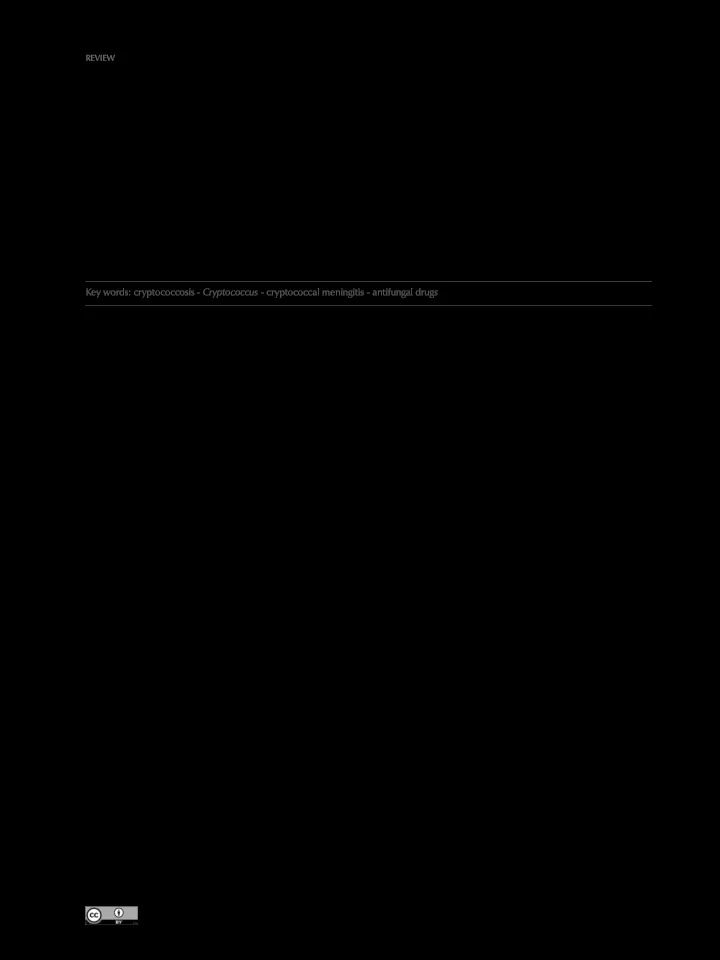

1| 7 REVIEW Mem Inst Oswaldo Cruz , Rio de Janeiro, Vol. 113 (7): e170391, 2018 The war on cryptococcosis: A Review of the antifungal arsenal Ahmad Mourad, John R Perfect/ + Duke University Medical Center, Department of Medicine, Division of Infectious Diseases, Durham, NC, USA Cryptococcal meningitis is the most common central nervous system infection in the world today. It occurs primarily, but not exclusively, in immunocompromised individuals and despite substantial improvement in management of clinical events like AIDS, the numbers of cases of cryptococcosis remain very high. Unfortunately, despite several antifungal agents available for treatment, morbidity and mortality rates remain high with this fungal infection. In this Review, we will describe the treatments and strategies for success, identify the failures, and provide insights into the future developments / improvements for management. This sugar-coated yeast can play havoc within the human brain. Our goals must be to either prevent or diagnose disease early and treat aggressively with all our clinical tools when disease is detected. Key words: cryptococcosis - Cryptococcus - cryptococcal meningitis - antifungal drugs Cryptococcosis is a global invasive mycosis that is as- can expect the number of patients with cryptococcosis to sociated with high morbidity and mortality. Patients with remain concerning (George et al. 2017). HIV infection are at a significantly increased risk of de- Antifungal drug therapy remains the mainstay of veloping this fungal disease. With its profound propensity treatment of these cryptococcal infections. This review to locate within the central nervous system (CNS), Cryp- aims at highlighting the drugs and strategies utilized for tococcus spp. frequently causes fungal meningitis. In fact, the management of this life- threatening infection, as this encapsulated yeast remains the most common cause well as the new developments in treatment. of meningitis in HIV-infected individuals living in sub- Therapeutic principles for cryptococcal meningitis Saharan Africa. It is estimated that in 2014 there were over - Before examining the details of our arsenal, several 220,000 new cases of cryptococcal meningitis globally re- therapeutic principles for management of cryptococcal sulting in more than 180,000 deaths and is responsible for meningitis should be listed: (1) early diagnosis is helpful 15% of all AIDS-related deaths. Although the annual rate to a successful outcome of treatment with a lower burden of cryptococcal disease has decreased after the widespread of yeasts and less destruction from a persistent, dysregu- use of highly active anti-retroviral therapy (HAART) in lated immune system; (2) identification of new, old, and developed countries, the prevalence of cryptococcal in- changing risk factors is necessary to properly utilize our fection remains at a high level in low and middle-income outstanding biomarkers for disease; (3) a fungicidal an- countries despite the availability of HAART (Tenforde et ticryptococcal regimen that rapidly clears viable yeasts al. 2017). The one-year mortality after cryptococcal men- from the subarachnoid space is optimal management; (4) ingitis ranges from 10-30% in North America to up to 50- major complications of cryptococcal meningitis should 100% in low-income countries (Rajasingham et al. 2017, be carefully identified and managed. These include (a) Williamson 2017, Williamson et al. 2017). increased intracranial pressure and (b) development Furthermore, non-HIV patient populations are also of the immune reconstitution inflammatory syndrome at risk of cryptococcal infection, notably transplant re- (IRIS); (5) further understanding of in vitro anticrypto- cipients and patients on immunosuppressive therapies. coccal yeast susceptibility testing for resistance (there are For example, approximately 2-3% of solid organ recipi- no validated drug break points) and strain evaluation ge- ents have been found to develop cryptococcal infection netically for identification of possible “bad actor” strains with most patients presenting with disseminated infection will be helpful. This area requires further research to be- (Larsen et al. 1994, Mayanja-Kizza et al. 1998, Milefchik come more clinically relevant and precise; (6) we must et al. 2008, Pappas et al. 2009). With over 33,000 solid control the concomitant underlying diseases at all costs organ transplants performed in the United States alone in and this will likely demand attention to the “Goldilocks’s 2016, the number of cryptococcal infection cases remains Paradigm of Immunology, not too much and not too little unacceptably high (HRSA 2017). With our increasing but must get it just right”; (7) our goal is to reduce mor- use of immune-modulators from corticosteroids, biologi- tality but it must also be accompanied by a reduction in cal modifiers (i.e. anti-TNF and anti-CD54) to new anti- morbidity, which is less chronicled in present reviews. cancer agents such as ibrutinib (Messina et al. 2017), we Amphotericin B & flucytosine (5-FC) - The polyene, amphotericin B, has been the mainstay of treatment of cryptococcal meningitis in HIV-infected individuals and transplant recipients as well as non-HIV and non-trans- doi: 10.1590/0074-02760170391 plant patients for several decades. Using a polyene-based + Corresponding author: john.perfect@duke.edu regimen has been associated with significant reduction Received 25 September 2017 of the yeast burden within the CNS and is correlated Accepted 23 November 2017 online | memorias.ioc.fiocruz.br
Recommend
More recommend